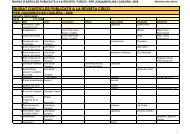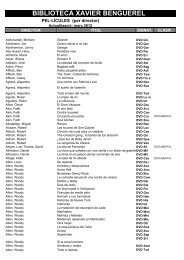Amphibians in the Region of Murcia (SE Iberian peninsula ... - Raco
Amphibians in the Region of Murcia (SE Iberian peninsula ... - Raco
Amphibians in the Region of Murcia (SE Iberian peninsula ... - Raco
Create successful ePaper yourself
Turn your PDF publications into a flip-book with our unique Google optimized e-Paper software.
Animal Biodiversity and Conservation 29.1 (2006)33<strong>Amphibians</strong> <strong>in</strong> <strong>the</strong> <strong>Region</strong> <strong>of</strong> <strong>Murcia</strong>(<strong>SE</strong> <strong>Iberian</strong> pen<strong>in</strong>sula):conservation status and priority areasA. Egea–Serrano, F. J. Oliva–Paterna & M. TorralvaEgea–Serrano, A., Oliva–Paterna, F. J. & Torralva, M., 2006. <strong>Amphibians</strong> <strong>in</strong> <strong>the</strong> <strong>Region</strong> <strong>of</strong> <strong>Murcia</strong> (<strong>SE</strong> <strong>Iberian</strong>pen<strong>in</strong>sula): conservation status and priority areas. Animal Biodiversity and Conservation, 29.1: 33–41.Abstract<strong>Amphibians</strong> <strong>in</strong> <strong>the</strong> <strong>Region</strong> <strong>of</strong> <strong>Murcia</strong> (<strong>SE</strong> <strong>Iberian</strong> pen<strong>in</strong>sula): conservation status and priority areas.— Theconservation status <strong>of</strong> amphibian species was studied <strong>in</strong> <strong>the</strong> <strong>Region</strong> <strong>of</strong> <strong>Murcia</strong>, tak<strong>in</strong>g <strong>in</strong>to consideration 10variables concern<strong>in</strong>g <strong>the</strong>ir biology and distribution. The results obta<strong>in</strong>ed show that <strong>the</strong> amphibian speciesexposed to <strong>the</strong> highest risk <strong>of</strong> ext<strong>in</strong>ction <strong>in</strong> <strong>the</strong> study area are those with long larval development and arestricted distribution range. Accord<strong>in</strong>g to this species classification, an <strong>in</strong>dex is proposed for assess<strong>in</strong>gareas whose conservation is <strong>of</strong> <strong>the</strong> highest priority. In <strong>the</strong> <strong>Region</strong> <strong>of</strong> <strong>Murcia</strong>, most <strong>of</strong> <strong>the</strong>se areas are located<strong>in</strong> <strong>the</strong> ma<strong>in</strong> mounta<strong>in</strong> systems, primarily conf<strong>in</strong>ed to <strong>the</strong> northwest. <strong>Region</strong>al Parks and proposed priorityconservation areas overlap by only about 12%. The current isolation <strong>of</strong> <strong>the</strong>se areas makes it necessary toundertake habitat restoration programmes to ensure <strong>the</strong>ir <strong>in</strong>terconnection.Key words: <strong>Amphibians</strong>, <strong>Region</strong> <strong>of</strong> <strong>Murcia</strong>, Species conservation, Priority areas.ResumenAnfibios en la Región de <strong>Murcia</strong> (<strong>SE</strong> península ibérica): estatus de conservación y áreas prioritarias.— Seha analizado el estado de conservación de las especies de anfibios presentes en la región de <strong>Murcia</strong> enfunción de 10 variables relacionadas con la biología y distribución de dichas especies. Los resultadosobtenidos muestran que las especies de anfibios expuestas al mayor riesgo de ext<strong>in</strong>ción en el área deestudio son aquéllas que presentan un desarrollo larvario prolongado y una distribución restr<strong>in</strong>gida. Enfunción de esta clasificación de las especies, se propone un índice que permita evaluar las áreas cuyaconservación es prioritaria. En la Región de <strong>Murcia</strong>, la mayor parte de estas áreas están localizadas en lospr<strong>in</strong>cipales sistemas montañosos y limitadas pr<strong>in</strong>cipalmente a la comarca nordoccidental del área deestudio. El solapamiento entre los Parques <strong>Region</strong>ales y las áreas propuestas de conservación prioritariaes sólo del 12%. El aislamiento actual de estas áreas hace necesario emprender programas de restauracióndel hábitat para garantizar su conexión.Palabras clave: Anfibios, Región de <strong>Murcia</strong>, Conservación de especies, Áreas prioritarias.(Received: 29 VI 05; Conditional acceptance: 20 IX 05; F<strong>in</strong>al acceptance: 10 X 05)A. Egea–Serrano, F. J. Oliva–Paterna & M. Torralva, Dept. de Zoología y Antropología Física, Fac. deBiología, Univ. de <strong>Murcia</strong>, 30100 <strong>Murcia</strong>, España (Spa<strong>in</strong>).Correspond<strong>in</strong>g author: A. Egea–Serrano. E–mail: aegea@um.esISSN: 1578–665X© 2006 Museu de Ciències Naturals
34 Egea–Serrano et al.IntroductionEnvironmental alteration as a consequence <strong>of</strong>anthropic activity is considered to have contributedto <strong>the</strong> decl<strong>in</strong>e <strong>of</strong> numerous amphibian populationsthroughout <strong>the</strong> world (Wake, 1991; Galán, 1997;Pechman & Wake, 1997; Marco, 2002a, 2002b). Acomplete <strong>in</strong>ventory <strong>of</strong> amphibian species present <strong>in</strong>a determ<strong>in</strong>ed territory, as well as its distributionrange, is <strong>of</strong> priority <strong>in</strong>terest. Such <strong>in</strong>formation wouldprovide a basic tool to establish <strong>the</strong> regional conservationstatus <strong>of</strong> <strong>the</strong> different species (UICN,2003) and consequently, to develop managementprogrammes to ensure <strong>the</strong>ir conservation (Palomo& Antúnez, 1992). Monitor<strong>in</strong>g efforts have enabledconservation status to be established on wide spatialscales (Pleguezuelos et al., 2002). Never<strong>the</strong>less,determ<strong>in</strong><strong>in</strong>g distribution and conservation statusat a regional scale is also necessary s<strong>in</strong>ce<strong>the</strong>se parameters can vary greatly for a given speciesfrom one region to ano<strong>the</strong>r (Gärdenfors et al.,1999, 2001).In addition to species conservation, ano<strong>the</strong>r target<strong>in</strong> conservation biology is to prioritize areas on<strong>the</strong> basis <strong>of</strong> <strong>the</strong>ir biological value (Su<strong>the</strong>rland, 2000),select<strong>in</strong>g those which show <strong>the</strong> highest priority.Such areas could represent a valuable tool forestablish<strong>in</strong>g conservation and management programmes.As regards amphibians, some studieshave established important areas for herpet<strong>of</strong>aunaconservation <strong>in</strong> <strong>the</strong> <strong>Iberian</strong> pen<strong>in</strong>sula (Santos et al.,1998; Mateo, 2002). These studies <strong>in</strong>clude <strong>the</strong><strong>Region</strong> <strong>of</strong> <strong>Murcia</strong> consider amphibian and reptilespecies toge<strong>the</strong>r, and no such studies establishpriority areas <strong>in</strong> this territory as a function <strong>of</strong> amphibianspecies present alone.The <strong>Region</strong> <strong>of</strong> <strong>Murcia</strong> <strong>in</strong> <strong>the</strong> sou<strong>the</strong>rn <strong>Iberian</strong>pen<strong>in</strong>sula is considered one <strong>of</strong> <strong>the</strong> most importantareas <strong>in</strong> <strong>the</strong> Mediterranean region for its amphibianspecies diversity and/or endemic amphibians(Bork<strong>in</strong>, 1999). It is characterized by an arid climate(Vidal–Abarca et al., 1992), which makes itunfavorable for amphibians due to hydrologicalstress and lack <strong>of</strong> breed<strong>in</strong>g habitats that suchclimatic conditions represent. Moreover, <strong>the</strong>se factorsmake <strong>the</strong> amphibian species present <strong>in</strong> <strong>the</strong><strong>Region</strong> <strong>of</strong> <strong>Murcia</strong> more vulnerable to land usechanges affect<strong>in</strong>g this area (Martínez & Esteve,2003) as <strong>the</strong>y <strong>in</strong>volve a severe habitat degradationprocess. Several studies deal<strong>in</strong>g with amphibianbiology and distribution (Miñano et al., 2003; Egea–Serrano, 2005; Egea–Serrano et al., 2005a, 2005b,2005c, 2005d, 2005e, 2005f) have been performed.Never<strong>the</strong>less, to date, <strong>the</strong>re has been no studyconcern<strong>in</strong>g <strong>the</strong> risk <strong>of</strong> ext<strong>in</strong>ction <strong>of</strong> amphibians <strong>in</strong><strong>the</strong> <strong>Region</strong> <strong>of</strong> <strong>Murcia</strong>.The objectives <strong>of</strong> <strong>the</strong> present study were todevelop a methodology based on <strong>the</strong> biological andecological constra<strong>in</strong>ts and distributions <strong>of</strong> amphibianspecies to evaluate <strong>the</strong> risk <strong>of</strong> ext<strong>in</strong>ction <strong>of</strong> <strong>the</strong>species present <strong>in</strong> <strong>the</strong> <strong>Region</strong> <strong>of</strong> <strong>Murcia</strong> and toestablish areas whose conservation should be consideredpriority.Material and methodsThe study area is restricted to <strong>the</strong> <strong>Region</strong> <strong>of</strong> <strong>Murcia</strong>(<strong>SE</strong> <strong>Iberian</strong> pen<strong>in</strong>sula). This territory <strong>in</strong>cludes most<strong>of</strong> <strong>the</strong> Segura River bas<strong>in</strong>, one <strong>of</strong> <strong>the</strong> most arid <strong>of</strong> <strong>the</strong><strong>Iberian</strong> pen<strong>in</strong>sula (Vidal–Abarca et al., 1987) and,probably, <strong>of</strong> Europe (Geiger, 1973). Eleven ecologicalsectors have been recognised <strong>in</strong> this bas<strong>in</strong> (Vidal–Abarca et al., 1990), most <strong>of</strong> <strong>the</strong>m exposed to a dry,hot and arid climate. However, dur<strong>in</strong>g <strong>the</strong> last threedecades land uses <strong>in</strong> <strong>the</strong> study area have been<strong>in</strong>creas<strong>in</strong>gly devoted to extensive agricultural irrigationpractices (Martínez & Esteve, 2003), while traditionalland uses (non–irrigated agricultural farms)are restricted to <strong>the</strong> northwestern region <strong>of</strong> <strong>the</strong> studyarea (Pérez & Lemeunier, 2003).Follow<strong>in</strong>g Andreone & Luiselli (2000) and Filippi& Luiselli (2000), 10 biological and ecologicalvariables were analysed. These variables <strong>in</strong>cludeaspects deal<strong>in</strong>g with <strong>the</strong> distribution, demography,ecology and taxonomy <strong>of</strong> <strong>the</strong> species present <strong>in</strong><strong>the</strong> study area. Data for <strong>the</strong>se variables wereobta<strong>in</strong>ed from <strong>the</strong> bibliography, as well as from <strong>the</strong>experience <strong>of</strong> <strong>the</strong> authors (table 1). Independentvariables were categorised, rang<strong>in</strong>g from <strong>the</strong> lowest(category 0) to <strong>the</strong> highest (categories 2, 3, 4,10, depend<strong>in</strong>g on <strong>the</strong> variable) risk <strong>of</strong> ext<strong>in</strong>ction.The variables considered <strong>in</strong> this study are relatedas follows, as well as <strong>the</strong>ir categories and <strong>the</strong>rationale for <strong>the</strong> choice <strong>of</strong> <strong>the</strong>se scores.Species presence <strong>in</strong> <strong>the</strong> <strong>Region</strong> <strong>of</strong> <strong>Murcia</strong>, basedon data presented by Egea–Serrano et al. (2005b,2005c): 0. Present <strong>in</strong> >50% <strong>of</strong> <strong>the</strong> study area surface;1. Present <strong>in</strong> 10–50%; 2. Present <strong>in</strong> 5–10%; 3.Present <strong>in</strong> 200 eggs/newborns; 1. 50–200; 2. 10–50; 3.
Animal Biodiversity and Conservation 29.1 (2006) 35Table 1. Bibliographic references used to def<strong>in</strong>e scores for studied species for each threaten<strong>in</strong>gfactor: RS. Reproductive strategy; EN. Egg (<strong>of</strong>fspr<strong>in</strong>g) number; H. Habits; MA. Maximum age; BH.Breed<strong>in</strong>g habitat; TU. Taxonomic uniqueness; 1. Alcobendas & Buckley, 2002; 2. Arntzen & García–París, 1995; 3. Barbadillo et al., 1999; 4. Bosch, 2003; 5. Busack, 1986; 6. Díaz–Paniagua, 1986;7. Egea–Serrano et al., 2005e; 8. Egea–Serrano et al., 2005f; 9. Esteban et al., 2004; 10. García–París et al., 2003; 11. García–París, 2004; 12. Guyétant et al., 1999; 13. Lizana et al., 1994; 14.Martínez–Solano & García–París, 2002; 15. Martínez–Solano et al., 2003; 16. Montori & Herrero,2004; 17. Nöllert & Nöllert, 1995; 18. Rebelo & Caetano, 1995; 19. Salvador & García–París, 2001;20. Salvador, 2005; 21. Toxopeus et al., 1993; * Experience <strong>of</strong> <strong>the</strong> authors.Tabla 1. Referencias bibliográficas utilizadas para def<strong>in</strong>ir las puntuaciones de las especies de anfibiosestudiadas para cada factor de riesgo: RS. Estrategia reproductiva; EN. Número de huevos(descendientes); H. Hábitos; MA. Edad máxima; BH. Hábitat reproductor; TU. Exclusividad taxonómica;* Experiencia de los autores. (Para las otras abreviaturas ver arriba.)Species RS EN H MA BH TUSalamandra salamandra 10 * 16 18 7 1, 10, 16Rana perezi 6 19 11, * 19 8, * 19Alytes dickhilleni 15, 20 4 20, 11 4 19, * 2, 11Alytes obstetricans 4 4 4, 11 4 11, * 2, 11Bufo calamita 6 19 3, 19 19 19, * 19Bufo bufo 6 19 3, 19 19 11, * 19Pelodytes punctatus 6 12, 21 12, 21 9 3, 19, * 19Discoglossus jeanneae 19 19 19 19 14 5, 11Pelobates cultripes 6, 13 19 11 17, 3 13, 19, * 19cies present <strong>in</strong> three sectors; 9. Species present <strong>in</strong>two sectors; 10. Species present <strong>in</strong> one sector. Thisvariable reflects species tolerance for environmentalvariables.Habits <strong>of</strong> adult phase: 0. Nocturnal fossorialspecies or with aquatic activity; 1. Nocturnal species;2. Diurnal species with cryptic habits; 3.Diurnal species with obvious habits. It is assumedthat obvious species are more exposed toman and predator persecution.Maximum age: 0. > 15 years; 1. 11–15 years; 2.6–10 years; 3. 1–5 years.Adaptability to altered environments: based on<strong>the</strong> experience <strong>of</strong> <strong>the</strong> authors: 0. Species extremelyadaptable (found even <strong>in</strong> urban parks); 1.Adaptable species (found <strong>in</strong> suburbia <strong>in</strong>term<strong>in</strong>gledwith small natural fields); 2. Species scarcelyadaptable (found <strong>in</strong> medium sized natural habitat);3. Unadaptable species (found only <strong>in</strong> largepatches <strong>of</strong> natural habitat).Altitud<strong>in</strong>al distribution: based on data presentedby Egea–Serrano et al. (2005d). 0. Ubiquitous; 1.Present at high elevations (> 900 m); 2. Speciespresent at a wide range <strong>of</strong> medium altitudes;3. Estenohypse species found at medium altitudes;4. Estenohypse species found at medium altitudes,but restricted to high plateaus. In <strong>the</strong> study area,sites located at high altitudes are more mounta<strong>in</strong>ousthan <strong>the</strong> rest, which makes <strong>the</strong>m <strong>in</strong>accessiblefor most human activies. Species present at highaltitudes are <strong>the</strong>refore more protected from habitatdegradation result<strong>in</strong>g from anthropic activities thanthose <strong>in</strong>habit<strong>in</strong>g less mounta<strong>in</strong>ous localities.Breed<strong>in</strong>g habitat: 0. Taxon which breeds <strong>in</strong> temporaland permanent water bodies; 1. Taxon whichbreeds <strong>in</strong> temporal water bodies; 2. Taxon whichbreeds <strong>in</strong> permanent water bodies. It is assumed thatspecies that breed <strong>in</strong> both permanent and temporalwater bodies can better face <strong>the</strong> pressure result<strong>in</strong>gfrom anthropogenic activities than species that onlybreed <strong>in</strong> permanent water bodies, most <strong>of</strong> which <strong>in</strong><strong>the</strong> study area are dedicated to farm<strong>in</strong>g activities.Taxonomic uniqueness: 0. Species <strong>of</strong> a polytypicgenus with more than three recognised subspecies;1. Species <strong>of</strong> a polytypic genus with 1–3recognised subspecies; 2. Monotypic species <strong>of</strong> apolytypic genus; 3. Species <strong>of</strong> a monotypic genus.It is assumed that a species recognised as represent<strong>in</strong>ga monotypic genus has more importancefrom a conservation po<strong>in</strong>t <strong>of</strong> view.All environmental variables were submitted to amultifactorial analysis to classify different amphibianspecies depend<strong>in</strong>g on <strong>the</strong>ir similarities <strong>in</strong> relationto <strong>the</strong>ir risk <strong>of</strong> ext<strong>in</strong>ction, a methodology successfullyused <strong>in</strong> previous studies on amphibiansand reptiles (Andreone & Luiselli, 2000; Filippi &
36 Egea–Serrano et al.Luiselli, 2000). Accord<strong>in</strong>g to <strong>the</strong>se authors, thisstatistical approach allows studied species to begrouped <strong>in</strong> a more suitable way than univariatetechniques s<strong>in</strong>ce relations between variables canbe established. Anuran and urodele species wereanalysed toge<strong>the</strong>r because no <strong>in</strong>formation is availableconcern<strong>in</strong>g <strong>the</strong> ma<strong>in</strong> differences between <strong>the</strong>setwo groups <strong>in</strong> relation to <strong>the</strong>ir biology and sensitivityto habitat degradation. The multifactorial analysisused was a multiple correspondence analysis(MCA). This statistical technique allows <strong>in</strong>formationprovided by orig<strong>in</strong>al data to be reduced to twodimensions which expla<strong>in</strong> most data variance, andassigns a new coord<strong>in</strong>ate to each case for eachdimension extracted by <strong>the</strong> analysis (Visauta, 1998).Accord<strong>in</strong>g to <strong>the</strong> values obta<strong>in</strong>ed for each dimension,species have been assigned to one <strong>of</strong> <strong>the</strong>follow<strong>in</strong>g categories, rang<strong>in</strong>g from low to high risk<strong>of</strong> ext<strong>in</strong>ction: 1. Species show<strong>in</strong>g positive values forboth dimensions (low risk <strong>of</strong> ext<strong>in</strong>ction); 2. Speciesshow<strong>in</strong>g positive values for dimension 1 and negativevalues for dimension 2 (low–medium risk <strong>of</strong>ext<strong>in</strong>ction); 3. Species show<strong>in</strong>g negative values fordimension 1 and positive values for dimension 2(medium–high risk <strong>of</strong> ext<strong>in</strong>ction); 4. Species show<strong>in</strong>gnegative values for both dimensions (high risk<strong>of</strong> ext<strong>in</strong>ction).To establish priority conservation areas from <strong>the</strong>po<strong>in</strong>t <strong>of</strong> view <strong>of</strong> <strong>the</strong> amphibian species present, <strong>the</strong>surface area <strong>of</strong> <strong>the</strong> <strong>Region</strong> <strong>of</strong> <strong>Murcia</strong> was divided<strong>in</strong>to a 5 x 5 km UTM grid. The number <strong>of</strong> amphibianspecies present for each square was determ<strong>in</strong>edaccord<strong>in</strong>g to <strong>in</strong>formation presented by Egea–Serranoet al. (2005b, 2005c). Additionally, <strong>the</strong> proportion <strong>of</strong>squares occupied by each species was calculated<strong>in</strong> relation to <strong>the</strong> number <strong>of</strong> 5 x 5 UTM squares <strong>in</strong>towhich <strong>the</strong> study area was divided. This procedureallowed to estimate species extension <strong>in</strong> <strong>the</strong> studyarea, establish<strong>in</strong>g an <strong>in</strong>dex <strong>of</strong> area occupation <strong>in</strong><strong>Murcia</strong> (D) with five categories rang<strong>in</strong>g from high tolow presence: 1. Species present <strong>in</strong> > 30% <strong>of</strong> <strong>the</strong>surface <strong>of</strong> <strong>the</strong> region. This area corresponds to <strong>the</strong>area <strong>of</strong> occupancy <strong>of</strong> a species considered as NearThreatened or Least Concern accord<strong>in</strong>g to UICNcategories (UICN, 2001). 2. Species present <strong>in</strong> 10–30% <strong>of</strong> <strong>the</strong> surface <strong>of</strong> <strong>the</strong> region. This area correspondsto <strong>the</strong> area <strong>of</strong> occupancy <strong>of</strong> a specieswhose risk <strong>of</strong> ext<strong>in</strong>ction can be considered <strong>in</strong>termediatebetween Near Threatened or Lleast Concernand Vulnerable categories, accord<strong>in</strong>g to UICN criteria(UICN, 2001). 3. Species present <strong>in</strong> 5–10% <strong>of</strong><strong>the</strong> surface <strong>of</strong> <strong>the</strong> region. This area corresponds to<strong>the</strong> area <strong>of</strong> occupancy <strong>of</strong> a species consideredVulnerable accord<strong>in</strong>g to UICN categories (UICN,2001). 4. Species present <strong>in</strong> 1–5% <strong>of</strong> <strong>the</strong> surface <strong>of</strong><strong>the</strong> region. This area corresponds to <strong>the</strong> area <strong>of</strong>occupancy <strong>of</strong> a species whose risk <strong>of</strong> ext<strong>in</strong>ction canbe considered <strong>in</strong>termediate between Vulnerable andEndangered categories, accord<strong>in</strong>g to UICN criteria(UICN, 2001). 5. Species present <strong>in</strong> < 1% <strong>of</strong> <strong>the</strong>surface <strong>of</strong> <strong>the</strong> region. This area corresponds to <strong>the</strong>area <strong>of</strong> occupancy <strong>of</strong> a species considered Endangeredaccord<strong>in</strong>g to UICN categories (UICN, 2001).Consider<strong>in</strong>g <strong>the</strong> calculated amphibian distributiondata, number <strong>of</strong> species per square and <strong>the</strong>previously calculated risk <strong>of</strong> ext<strong>in</strong>ction for eachspecies, a biological value was calculated for each5 x 5 km square through <strong>the</strong> expression:(MCA i+D i)+Spp jwhere MCA iis <strong>the</strong> risk <strong>of</strong> ext<strong>in</strong>ction for species i, D iis <strong>the</strong> distribution <strong>of</strong> species i <strong>in</strong> <strong>the</strong> <strong>Region</strong> <strong>of</strong><strong>Murcia</strong>, and Spp j<strong>the</strong> number <strong>of</strong> amphibian speciesfor j square.Squares show<strong>in</strong>g values higher than <strong>the</strong> 75 thpercentile for this <strong>in</strong>dex were selected as priorityconservation squares.Statistical analysis were performed with <strong>the</strong>SPSS ® statistical package.ResultsThe scores for <strong>the</strong> <strong>in</strong>dependent variables for <strong>the</strong>amphibian species <strong>in</strong> <strong>the</strong> <strong>Region</strong> <strong>of</strong> <strong>Murcia</strong> arepresented <strong>in</strong> table 2. The results provided by multiplecorrespondence analysis have enabled identification<strong>of</strong> three groups <strong>of</strong> species (fig. 1). Table 3shows <strong>the</strong> scores for each variable <strong>in</strong> each dimensionextracted by <strong>the</strong> MCA. Breed<strong>in</strong>g habitat comb<strong>in</strong>ed<strong>the</strong> highest value for dimension 1 (0.770) and<strong>the</strong> lowest for dimension 2 (0.067), whereas speciespresence presented <strong>the</strong> lowest value for dimension1 (0.682) and <strong>the</strong> highest for dimension 2(0.911). This implies that <strong>the</strong> ma<strong>in</strong> variables arrang<strong>in</strong>gspecies through dimension 1 and dimension2 <strong>in</strong> <strong>the</strong> <strong>Region</strong> <strong>of</strong> <strong>Murcia</strong> are, respectively,breed<strong>in</strong>g habitat and species presence.Table 4 shows <strong>the</strong> values obta<strong>in</strong>ed for variablesrisk <strong>of</strong> ext<strong>in</strong>ction and extension <strong>in</strong> <strong>the</strong> study area foreach amphibian species.The 5 x 5 km UTM squares show<strong>in</strong>g biologicalvalue <strong>in</strong>dices higher than <strong>the</strong> 75 th percentile wereconsidered as priority conservation areas. The totalnumber <strong>of</strong> such areas added up to 103 (fig. 2) andrepresented 16% <strong>of</strong> <strong>the</strong> surface <strong>of</strong> <strong>the</strong> <strong>Region</strong> <strong>of</strong><strong>Murcia</strong>.DiscussionAlthough Andreone & Luiselli (2000) <strong>in</strong>dicate thatboth univariate and multivariate methodology sufficientlycharacterise <strong>the</strong> conservation status <strong>of</strong> aspecies group, multivariate analysis alone wasused <strong>in</strong> <strong>the</strong> present study as univariate analysis isconsidered to have <strong>the</strong> disadvantage <strong>of</strong> not establish<strong>in</strong>grelationships between variables and <strong>the</strong>reforenot realistically rank<strong>in</strong>g <strong>the</strong> studied speciesaccord<strong>in</strong>g to <strong>the</strong>ir risk <strong>of</strong> ext<strong>in</strong>ction.The results obta<strong>in</strong>ed show that <strong>the</strong> speciesexposed to higher risk <strong>of</strong> ext<strong>in</strong>ction are thosewhich depend on <strong>the</strong> presence <strong>of</strong> permanent waterbodies to complete <strong>the</strong>ir larval development andwhich, <strong>in</strong> addition, show a restricted distribution
38 Egea–Serrano et al.Table 3. Scores for two dimensions extractedby multiple correspondence analysis for<strong>in</strong>dependent variables: E. Eigenvalue. (Forabbreviations see table 2.)Tabla 3. Puntuaciones para las dos dimensionesextraídas por el análisis de correspondenciamúltiple para las variables <strong>in</strong>dependientes. (Paralas abreviaturas ver tabla 2.)Table 4. Scores for amphibian speciesexist<strong>in</strong>g <strong>in</strong> <strong>the</strong> region <strong>of</strong> <strong>Murcia</strong> for <strong>the</strong>variables risk <strong>of</strong> ext<strong>in</strong>ction (RE) and extension<strong>of</strong> distributiion (E).Tabla 4. Puntuaciones de las especies deanfibios presentes en la región de <strong>Murcia</strong>para las variables riesgo de ext<strong>in</strong>ción (RE) yextensión de distribución (E).Dimension 1 Dimension 2Variable (E = 0.63) (E = 0.44)P 0.682 0.911RS 0.369 0.031EN 0.687 0.059HB 0.954 0.939H 0.234 0.229MA 0.308 0.260AE 0.917 0.485AD 0.943 0.937BH 0.770 0.067TU 0.499 0.551Species RE ES. salamandra 3 4A. dickhilleni 3 4A. obstetricans 3 4D. jeanneae 3 5B. calamita 1 2B. bufo 2 3P. punctatus 2 3P. cultripes 2 4R. perezi 1 1salamandra, A. dickhilleni, A. obstetricans and D.jeanneae. However, when <strong>the</strong> IUCN Red ListCriteria are applied to <strong>the</strong>se species at a worldwidelevel (UICN, 2001), only A. dickhhilleni isdescribed as vulnerable (IUCN, 2004). Never<strong>the</strong>less,<strong>the</strong> group formed by <strong>the</strong> above speciesshows a higher risk <strong>of</strong> ext<strong>in</strong>ction than <strong>the</strong> o<strong>the</strong>rstudied species when <strong>the</strong> IUCN Red List Criteriaat country level (UICN, 2003) are applied(Pleguezuelos et al., 2002).The degree <strong>of</strong> agreementbetween this classification and our resultswas good. In relation to <strong>the</strong> rema<strong>in</strong><strong>in</strong>g speciesstudied, although <strong>the</strong>y have not been evaluatedat a worldwide level (IUCN, 2004), when <strong>the</strong>IUCN Red List Criteria are applied at countrylevel (UICN, 2003) <strong>the</strong>y are not classified separately(Pleguezuelos et al., 2002); <strong>the</strong>y all show alow risk <strong>of</strong> ext<strong>in</strong>ction (Least Concern). In contrastwith this classification, <strong>the</strong> <strong>in</strong>dex applied at aregional level <strong>in</strong> <strong>the</strong> present study identified agroup <strong>of</strong> species exposed to a low–medium risk<strong>of</strong> ext<strong>in</strong>ction (B. bufo, P. punctatus and P. cultripes)and ano<strong>the</strong>r group with a low risk <strong>of</strong> ext<strong>in</strong>ction(R. perezi and B. calamita). This difference demonstrates<strong>the</strong> importance <strong>of</strong> a spatial scale <strong>in</strong>evaluat<strong>in</strong>g a taxon´s risk <strong>of</strong> ext<strong>in</strong>ction.If a species <strong>in</strong> a region is considered threatened(as is <strong>the</strong> case <strong>of</strong> S. salamandra, A.dickhilleni, A. obstetricans and D. jeanneae <strong>in</strong><strong>Murcia</strong>) measures must be taken to ensure <strong>the</strong>conservation <strong>of</strong> <strong>the</strong>se populations <strong>in</strong> this territory.Such measures should <strong>in</strong>clude <strong>the</strong> conservation<strong>of</strong> traditional farm<strong>in</strong>g practices because <strong>the</strong>sewould contribute to preserv<strong>in</strong>g terrestrial habitatssuitable for <strong>the</strong> adult <strong>in</strong>dividuals <strong>of</strong> many species,as well as water bodies where many species canf<strong>in</strong>ish <strong>the</strong>ir larval development, as suggested byseveral authors (París et al., 2002; Martínez–Solano et al., 2004; unpublished data).The importance <strong>of</strong> mounta<strong>in</strong> systems <strong>in</strong> amphibianconservation <strong>in</strong> <strong>the</strong> <strong>Region</strong> <strong>of</strong> <strong>Murcia</strong> is clear.Most areas whose conservation has been consideredpriority <strong>in</strong> <strong>the</strong> present study (80%) are located<strong>in</strong> <strong>the</strong> ma<strong>in</strong> mounta<strong>in</strong>s <strong>of</strong> <strong>the</strong> study area, and havebeen proposed as Sites <strong>of</strong> Community Interest(Baraza, 1999). However, only 12% <strong>of</strong> <strong>the</strong> proposedpriority conservation areas are <strong>in</strong>cluded with<strong>in</strong><strong>Region</strong>al Parks (Baraza, 2003), <strong>the</strong> current legallyprotected areas.Mateo (2002) showed some <strong>of</strong> <strong>the</strong>se mounta<strong>in</strong>swere valuable areas for herpet<strong>of</strong>auna conservation,although amphibian and reptile species were consideredtoge<strong>the</strong>r. These areas are characterized byhabitats <strong>of</strong> community <strong>in</strong>terest, such as Tetracl<strong>in</strong>isarticulata, Quercus ilex, Quercus rotundifolia,Juniperus phoenicea, or Juniperus thurifera forests(Baraza, 1999), whose distribution range <strong>in</strong> <strong>the</strong>study area is restricted. Accord<strong>in</strong>g to our results,<strong>the</strong> area show<strong>in</strong>g <strong>the</strong> most noticeable lack <strong>of</strong> protectionis <strong>the</strong> north eastern part <strong>of</strong> <strong>the</strong> study area, aterritory where only three out <strong>of</strong> <strong>the</strong> 12 squaresestablished as priority conservation areas are <strong>in</strong>cluded<strong>in</strong> Sites <strong>of</strong> Communitary Interest or <strong>Region</strong>alParks.
Animal Biodiversity and Conservation 29.1 (2006) 39WHXHYGNWGXGUTM5 x 5 kmFig. 2. Distribution <strong>of</strong> areas <strong>of</strong> <strong>the</strong> highest conservation priority <strong>in</strong> <strong>the</strong> <strong>Region</strong> <strong>of</strong> <strong>Murcia</strong>.Fig. 2. Distribución de las áreas prioritarias de conservación en la Región de <strong>Murcia</strong>.The fact that most priority squares are concentrated<strong>in</strong> <strong>the</strong> northwestern area <strong>of</strong> <strong>the</strong> region, where<strong>the</strong>y co<strong>in</strong>cide with different protected areas, emphasises<strong>the</strong> biological value <strong>of</strong> this territory. Inaddition, <strong>the</strong> value <strong>of</strong> this area <strong>in</strong>creases because<strong>of</strong> its cultural importance from <strong>the</strong> po<strong>in</strong>t <strong>of</strong> view <strong>of</strong>traditional land use conservation (Pérez &Lemeunier, 2003).F<strong>in</strong>ally, it should be mentioned that most <strong>of</strong> <strong>the</strong>priority conservation areas suggested <strong>in</strong> this workare isolated as a consequence <strong>of</strong> <strong>the</strong> severe habitatdestruction that <strong>the</strong> <strong>Region</strong> <strong>of</strong> <strong>Murcia</strong> has undergone,and cont<strong>in</strong>ues to undergo, as a consequence<strong>of</strong> irrigation crop expansion (Martínez & Esteve,2003). Such severe environmental degradation meansthat only species show<strong>in</strong>g low ecological requirements,such as R. perezi, can survive, and it impliesthat most <strong>of</strong> <strong>the</strong> amphibian populations present <strong>in</strong><strong>the</strong> study area will rema<strong>in</strong> isolated. S<strong>in</strong>ce ensur<strong>in</strong>gcolonization and genetic flow from nearby populationsis an essential measure <strong>in</strong> amphibian conservation(Semlitsch, 2002), habitat restoration programmesneed to be undertaken to provide suitable habitatsfor different amphibian species. This would formbiological corridors that make <strong>in</strong>dividual migrationsfeasible. These aspects should be taken <strong>in</strong>to considerationwhen amphibian populations <strong>in</strong> <strong>the</strong> <strong>Region</strong> <strong>of</strong><strong>Murcia</strong> are subjected to management and/or recoveryprogrammes.AcknowledgementsPart <strong>of</strong> this research was supported by <strong>the</strong> EnvironmentalService <strong>of</strong> <strong>the</strong> Autonomous Government<strong>of</strong> <strong>Murcia</strong>, Spa<strong>in</strong>. We thank members <strong>of</strong>Group <strong>of</strong> Investigation Aquatic Vertebrates Conservation<strong>of</strong> <strong>the</strong> Zoology and Physical AnthropologyDepartment <strong>of</strong> <strong>the</strong> University <strong>of</strong> <strong>Murcia</strong> for<strong>the</strong>ir help <strong>in</strong> field sampl<strong>in</strong>g. We also thank PhilipThomas for <strong>the</strong> English translation.ReferencesAlcobendas, M. & Buckley, D., 2002. Salamandrasalamandra. In: Atlas y Libro Rojo de los Anfibiosy Reptiles de España: 55–57 (J. M. Pleguezuelos,R. Márquez & M. Lizana, Eds.). Dirección Generalde Conservación de la Naturaleza, Madrid.Andreone, F. & Luiselli, L., 2000. The Italianbatrach<strong>of</strong>auna and its conservation status: astatistical assessment. Biological Conservation,96: 197–208.Arntzen, J. W. & García–París, M., 1995. Morphologicaland allozyme studies <strong>of</strong> midwife toads(genus Alytes) <strong>in</strong>clud<strong>in</strong>g <strong>the</strong> description <strong>of</strong> twonew taxa from Spa<strong>in</strong>. Contribution to Zoology,65: 5–34.Baraza, F. (Coord.), 1999. Los hábitats comunitarios
40 Egea–Serrano et al.en la Región de <strong>Murcia</strong>. Consejería de Agricultura,Agua y Medio Ambiente, <strong>Murcia</strong>.– (Dir.), 2003. Estrategia regional para laconservación y el uso sostenible de la diversidadbiológica. Consejería de Agricultura, Agua y MedioAmbiente. Dirección General del Medio Natural,Región de <strong>Murcia</strong>.Barbadillo, L. J., Lacomba, J. I., Pérez–Mellado, V.,Sancho, V., López–Jurado, L. F., 1999. Anfibiosy Reptiles de la Península Ibérica, Baleares yCanarias. Editorial GeoPlaneta, Barcelona.Bork<strong>in</strong>, L. J., 1999. Distribution <strong>of</strong> <strong>Amphibians</strong> <strong>in</strong>North Africa, Europe, Western Asia, and <strong>the</strong>Former Soviet Union. In: Patterns <strong>of</strong> Distribution<strong>of</strong> <strong>Amphibians</strong>. A Global Perspective: 329–420(W. E. Duellman, Ed.). The Johns Hopk<strong>in</strong>s Univ.Press, Baltimore.Bosch, J., 2003. Sapo partero común– Alytesobstetricans. In: Enciclopedia Virtual de losVertebrados Españoles (L. M. Carrascal & A.Salvador, Eds.). Museo Nacional de CienciasNaturales, Madrid.http://www.vertebradosibericos.org/Busack, S. D., 1986. Biochemical and morphologicaldifferentiation <strong>in</strong> Spanish and Moroccanpopulations <strong>of</strong> Discoglossus and <strong>the</strong> description<strong>of</strong> a new species from souhtern Spa<strong>in</strong> (Amphibia,Anura, Discoglossidae). Annals <strong>of</strong> Carnegie Museum,55: 41–61.Díaz–Paniagua, C., 1986. Reproductive Period <strong>of</strong><strong>Amphibians</strong> <strong>in</strong> <strong>the</strong> Biological Reserve <strong>of</strong> Doñana(SW Spa<strong>in</strong>). In: Studies <strong>in</strong> Herpetology: 429–432(Z. Rocek, Ed.). Charles Univ., Praga.Egea–Serrano, A., 2005. La Comunidad de Anfibiosde la Comarca del Noroeste de la Región de<strong>Murcia</strong> (<strong>SE</strong> Península Ibérica): Patrón deDistribución y Estrategia Reproductora. Dissertation.Univ. <strong>of</strong> <strong>Murcia</strong>.Egea–Serrano, A., Oliva–Paterna, F. J., Miñano, P.,Verdiell, D., de Maya, J. A., Andreu, A., Tejedo,M. & Torralva, M., 2005a (<strong>in</strong> press). Distribuciónde los anfibios en la Región de <strong>Murcia</strong> (<strong>SE</strong>Península Ibérica): Actualización y estado deconservación de localidades reproductoras.Anales de Biología.Egea–Serrano, A., Oliva–Paterna, F. J. & Torralva,M., 2005b (<strong>in</strong> press). Caracterización altitud<strong>in</strong>alde la comunidad de anfibios de la Región de<strong>Murcia</strong> (<strong>SE</strong> Península Ibérica). Boletín de laAsociación Herpetológica Española.– 2005c (<strong>in</strong> press). Breed<strong>in</strong>g habitat selection <strong>of</strong>Salamandra salamandra (L<strong>in</strong>naeus, 1758) <strong>in</strong> <strong>the</strong>most arid zone <strong>of</strong> its European distribution range:application to conservation management.Hydrobiologia.– 2005d (<strong>in</strong> press). Selección de hábitat reproductorpor Rana perezi Seoane, 1885 en el NO de laRegión de <strong>Murcia</strong> (<strong>SE</strong> Península Ibérica). RevistaEspañola de Herpetología.– 2005e (<strong>in</strong> press). Fenología reproductiva de lacomunidad de anfibios presente en el noroestede la Región de <strong>Murcia</strong> (<strong>SE</strong> Península Ibérica).Zoologica Baetica.Egea–Serrano, A., Verdiell, D., de Maya, J. A.,Miñano, P., Andreu, A., Oliva–Paterna, F. J. &Torralva, M., 2005f (<strong>in</strong> press). Actualización delatlas de distribución de los anfibios en la Regiónde <strong>Murcia</strong> (<strong>SE</strong> Península Ibérica). Boletín de laAsociación Herpetológica Española.Esteban, M., Sánchez–Herráiz, M. J., Barbadillo, L.J. & Castanet, J., 2004. Age structure and growth<strong>in</strong> an isolated population <strong>of</strong> Pelodytes punctatus<strong>in</strong> nor<strong>the</strong>rn Spa<strong>in</strong>. Journal <strong>of</strong> Natural History, 38:2789–2801.Filippi, E. & Luiselli, L., 2000. Status <strong>of</strong> <strong>the</strong> Italiansnake fauna and assessment <strong>of</strong> conservationthreats. Biological Conservation, 93: 219–225.Galán, P., 1997. Declive de poblaciones de anfibiosen dos embalses de La Coruña (Noroeste deEspaña) por <strong>in</strong>troducción de especies exóticas.Boletín de la Asociación Herpetológica Española,8: 38–40.García–París, M., 2004. Anura. In: Amphibia,Lissamphibia: 275–480 (M. García–París, A.Montori & P. Herrero). Fauna Ibérica, vol. 24 (M.A. Ramos et al., Eds.). Museo Nacional deCiencias Naturales, Madrid.García–París, M., Alcobendas, M., Buckley, D. &Wake, D. B., 2003. Dispersal <strong>of</strong> viviparity acrosscontact zones <strong>in</strong> <strong>Iberian</strong> population <strong>of</strong> fire salamander(Salamandra) <strong>in</strong>ferred from discordante<strong>of</strong> genetic and morphological traits. Evolution,57: 129–143.Gärdenfors, U., Hilton–Taylor, C., Mace, G. M. &Rodríguez, J. P., 2001. The Application <strong>of</strong> IUCNRed List Criteria at <strong>Region</strong>al Levels. ConservationBiology, 15: 1206–1212.Gärdenfors, U., Rodríguez, J. P., Hilton–Taylor, C.,Hyslop, C., Mace, G. M., Molur, S. & Poss, S.,1999. Draft guidel<strong>in</strong>es for <strong>the</strong> application <strong>of</strong> IUCNRed List criteria at national and regional levels.Species, 31–32: 58–70.Geiger, F., 1973. El Sureste español y los problemasde la aridez. Revista de Geografía, VII: 166–209.Guyétant, R., Temmermans, W. & Avrillier, J. N.,1999. Phénologie de la reproduction chezPelodytes punctatus Daud<strong>in</strong>, 1802 (Amphibia,Anura). Amphibia–Reptilia, 20: 149–160.IUCN, 2004. Red List <strong>of</strong> Threatened Species.http://www.redlist.orgLizana, M., Márquez, R. & Martín–Sánchez, R.,1994. Reproductive biology <strong>of</strong> Pelobates cultripes(Anura: Pelobatidae) <strong>in</strong> Central Spa<strong>in</strong>. Journal <strong>of</strong>Herpetology, 28: 19–27.Marco, A., 2002a. Contam<strong>in</strong>ación global pornitrógeno y declive de anfibios. Revista Españolade Herpetología, 16: 5–17.– 2002b. Radiación ultravioleta y declive deanfibios. Quercus, 192: 30–37.Martínez, J. & Esteve, M. A., 2003. D<strong>in</strong>ámica ysostenibilidad ambiental de los regadíosmurcianos. In: Los recursos naturales de laRegión de <strong>Murcia</strong>. Un análisis <strong>in</strong>terdiscipl<strong>in</strong>ar:213–225 (M. A. Esteve, M. Lloréns & C. Martínez,Eds.). Univ. de <strong>Murcia</strong>, <strong>Murcia</strong>.Martínez–Solano, I. & García–París, M., 2002.
Animal Biodiversity and Conservation 29.1 (2006) 41Discoglossus jeanneae. In: Atlas y Libro Rojo delos Anfibios y Reptiles de España: 88–89 (J. M.Pleguezuelos, R. Márquez & M. Lizana, Eds.).Dirección General de Conservación de laNaturaleza, Madrid.Martínez–Solano, I., García–París, M. & Jiménez,S., 2004. Medidas para la conservación del sapopartero común en el sureste de Madrid. Quercus,219: 32–37.Martínez–Solano, I., París, M., Izquierdo, E. &García–París, M., 2003. Larval growth plasticity<strong>in</strong> populations <strong>of</strong> <strong>the</strong> betic midwife toad, Alytesdickhilleni (Anura: Discoglossidae). HerpetologicalJournal, 13: 89–94.Mateo, J. A., 2002. Áreas importantes para laherpet<strong>of</strong>auna española. In: Atlas y Libro Rojode los Anfibios y Reptiles de España: 485–500(J. M. Pleguezuelos, R. Márquez & M. Lizana,Eds.). Dirección General de Conservación de laNaturaleza–Asociación Herpetológica Española,Madrid.Miñano, P., Egea, A., Oliva– Paterna, F. J. & Torralva,M., 2003. Habitat reproductor de Salamandrasalamandra (L<strong>in</strong>naeus, 1758)en el Noroeste dela Región de <strong>Murcia</strong> (<strong>SE</strong> Península Ibérica):Distribución actualizada. Anales de Biología, 25:203–205.Montori, A. & Herrero, P., 2004. Caudata. In:Amphibia, Lissamphibia: 43–275 (M. García–París, A. Montori & P. Herrero). Fauna Ibérica,vol. 24 (M. A. Ramos et al., Eds.). Museo Nacionalde Ciencias Naturales, Madrid.Nöllert, A. & Nöllert, Ch., 1995. Los Anfibios deEuropa. Ediciones Omega, Barcelona.Palomo, L. J. & Antúnez, A., 1992. Los atlas dedistribución de especies. In: Objetivos yMétodos Biogeográficos. Aplicaciones enHerpetología: 39–50 (J. M. Vargas, R. Real &A. Antúnez, Eds.). Asociación HerpetológicaEspañola, Madrid.París, M., Martínez–Solano, I., Izquierdo, E. &García–París, M., 2002. Distribución y Estadode Conservación de los Sapos Parteros (Anura:Discoglossidae: Alytes) en la Prov<strong>in</strong>cia deAlbacete (Castilla–La Mancha, España). Sabuco,3: 5–22.Pechmann, J. H. K. & Wake, D. B., 1997. Decl<strong>in</strong>esand disappearances <strong>of</strong> amphibian populations.In: Pr<strong>in</strong>ciples <strong>of</strong> Conservation Biology: 135–137(G. K. Meffe & C. R. Carroll, Eds.). S<strong>in</strong>auerAssociates, Massachussetts.Pérez, M. T. & Lemeunier, G., 2003. Los sistemasagrarios de la Región de <strong>Murcia</strong> durante mediomilenio (1500–2000). In: Los recursos naturalesde la Región de <strong>Murcia</strong>. Un análisis <strong>in</strong>terdiscipl<strong>in</strong>ar:170–200 (M. A. Esteve, M. Lloréns & C. Martínez,Eds.). Univ. de <strong>Murcia</strong>, <strong>Murcia</strong>.Pleguezuelos, J. M., Márquez, R. & Lizana, M.(Eds.), 2002. Atlas y Libro Rojo de los Anfibios yReptiles de España. Dirección General deConservación de la Naturaleza–AsociaciónHerpetológica Española, Madrid.Rebelo, R. & Caetano, M. H., 1995. Use <strong>of</strong>skeletochronological method for ecodemographicalstudies on Salamandra salamandragallaica from Portugal. In: Scientia Herpetologica:135–140 (G. Llorente, A. Montori, X. Santos & M.A. Carretero, Eds.). Asociación HerpetológicaEspañola, Barcelona.Salvador, A., 2005. Sapo partero bético– Alytesdickhilleni. In: Enciclopedia Virtual de losVertebrados Españoles (L. M. Carrascal & A.Salvador, Eds.). Museo Nacional de CienciasNaturales, Madrid.http://www.vertebradosibericos.org/Salvador, A. & García–París, M., 2001. AnfibiosEspañoles. Identificación, Historia Natural yDistribución. Esfagnos, Talavera de la Re<strong>in</strong>a.Santos, X., Carretero, M. A., Llorente, G. A. &Montori, A. (Eds.), 1998. Inventario de las áreasimportantes para los anfibios y reptiles de España.Colección Técnica, ICONA, Madrid.Semlitsch, R. D., 2002. Critical Elements for BiologicallyBased Recovery Plans <strong>of</strong> Aquatic–Breed<strong>in</strong>g<strong>Amphibians</strong>. Conservation Biology, 16: 619–629.Su<strong>the</strong>rland, W. J., 2000. The Conservation Handbook.Research, Management and Policy.Blackwell Science, United K<strong>in</strong>gdom.Toxopeus, A. G., Ohm, M. & Arntzen, J. W., 1993.Reproductive biology <strong>of</strong> <strong>the</strong> parsley frog,Pelodytes punctatus, at <strong>the</strong> nor<strong>the</strong>rnest part <strong>of</strong>its range. Amphibia–Reptilia, 14: 131–147.UICN, 2001. Categorías y Criterios de la Lista Rojade la UICN: Versión 3.1. Comisión de Supervivenciade Especies de la UICN. UICN, Gland,Suiza y Cambridge, Re<strong>in</strong>o Unido.– 2003. Directrices para emplear los criterios de laLista Roja de la UICN a nivel regional: Versión3.0. Comisión de Supervivencia de Especies dela UICN. UICN, Gland, Suiza y Cambridge, Re<strong>in</strong>oUnido.Vidal–Abarca, M. R., Montes, C., Ramírez–Díaz, L.& Suárez, M. L., 1987. El Clima de la Cuenca delRío Segura (<strong>SE</strong> de España): Factores que locontrolan. Anales de Biología, 12: 11–28.Vidal–Abarca, M. R., Montes, C., Suárez, M. L. &Ramírez–Díaz, L., 1990. Sectorización ecológicade cuencas fluviales: aplicación a la cuenca delrío Segura (<strong>SE</strong> España). Anales de Geografía dela Universidad Complutense, 10: 149–182.Vidal–Abarca, M. R., Suárez, M. L. & Ramírez–Díaz, L., 1992. Ecology <strong>of</strong> Spanish semiaridstreams. Limnetica, 8: 151–160.Visauta, B., 1998. Análisis estadístico con SPSSpara W<strong>in</strong>dows. Estadística multivariante.McGraw–Hill/Interamericana de España, Madrid.Wake, D. B., 1991. Decl<strong>in</strong><strong>in</strong>g Amphibian Populations.Science, 253: 860.


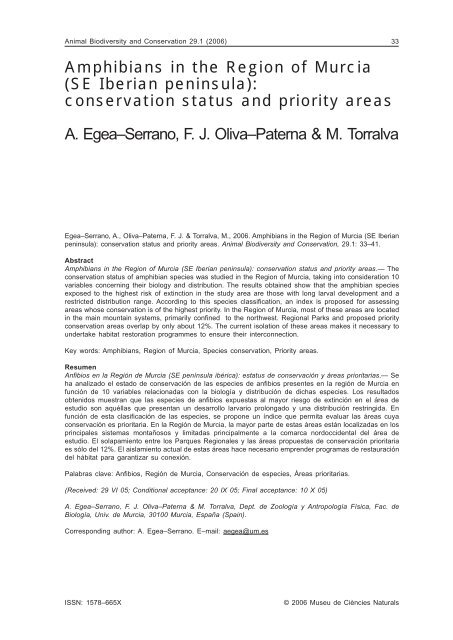
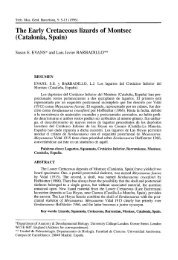
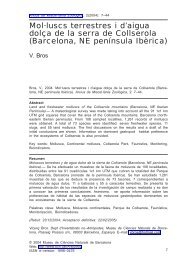
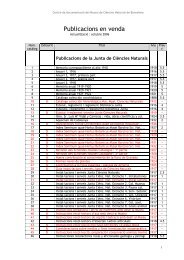
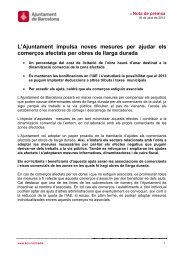
![[ pdf ] José Sanchis Sinisterra](https://img.yumpu.com/14886025/1/190x135/-pdf-jose-sanchis-sinisterra.jpg?quality=85)
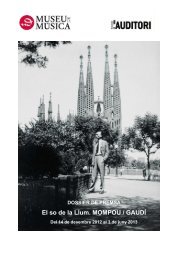
![[ pdf ] II Convenció Les veus de la gent gran 2004 - 2007](https://img.yumpu.com/14629010/1/190x182/-pdf-ii-convencio-les-veus-de-la-gent-gran-2004-2007.jpg?quality=85)

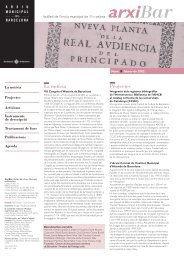

![[ pdf ] Material Escuela Pia Balmes](https://img.yumpu.com/14415004/1/184x260/-pdf-material-escuela-pia-balmes.jpg?quality=85)
